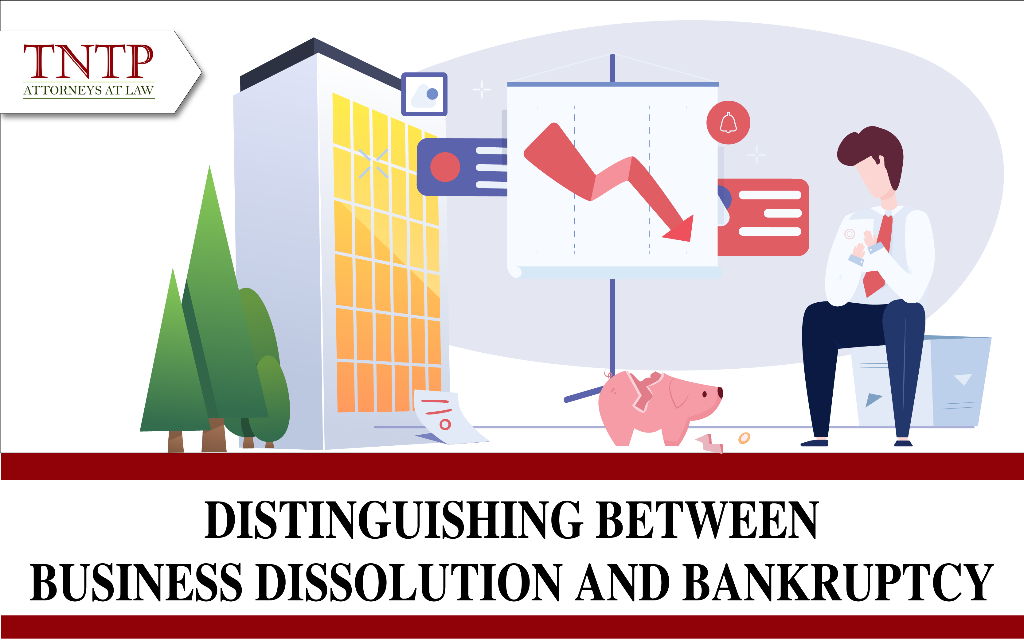Distinguishing between business dissolution and bankruptcy

In business operations, the terms “dissolution” and “bankruptcy” are often mentioned as final options for enterprises that can no longer continue operating. Although both lead to the termination of business activities, there are clear differences between them that need to be distinguished. Understanding the differences between dissolution and bankruptcy is crucial for businesses, investors, and stakeholders. In this article, TNTP will help readers Distinguishing between business dissolution and bankruptcy.
1. Concepts
• Business dissolution is the process of voluntarily or mandatorily ceasing the operations of a business, based on the decision of the business owner or a competent state authority. Dissolution typically occurs when a business does not want or is unable to continue operations due to economic, legal, or personal reasons.
• Bankruptcy is the condition in which a business or cooperative loses the ability to pay its debts and must undergo bankruptcy proceedings as intervened by the court. Additionally, the concept of insolvency is clearly defined in Clause 1, Article 4 of the Bankruptcy Law 2014, which states that a business or cooperative is insolvent when it fails to meet its debt payment obligations within three months from the due date.
2. Legal Basis
• Business dissolution: Based on the Law on Enterprise 2020 and its guiding documents.
• Bankruptcy: Based on the Law on Bankruptcy 2014 and its guiding documents.
3. Causes and Mandatory Conditions
• Based on Article 207 of the Law on Enterprise 2020, there are two forms of dissolution: voluntary dissolution and dissolution by the request of the state authority. However, to carry out dissolution, the business must ensure the payment of all debts and other financial obligations and must not be in the process of dispute resolution in court or arbitration.
Thus, a business can only dissolve if it ensures the payment of all debts, other financial obligations, and is not undergoing dispute resolution in court or arbitration.
• In contrast, bankruptcy occurs when a business or cooperative cannot pay its debts on time and cannot restore its solvency over a long period, nor can it promptly or fully compensate creditors or those entitled to claim debts.
Debt repayment is only conducted once bankruptcy proceedings are initiated and payment follows the priority order as stipulated in the law, and full debt repayment is not required if the business or cooperative’s assets are insufficient to cover the debts.
4. The parties with the right to request and the entities making the decision
• In cases of voluntary dissolution, the business owner decides on the dissolution. For mandatory dissolution, the business owner must dissolve the enterprise based on the decision by a competent authority to suspend operations, revoke the business registration certificates, or a court decision. The business registration authority does not have the power to approve or reject the dissolution but only to review the validity of the dissolution documents.
Those entitled to request business dissolution include the business owner for private enterprises, the General meeting of shareholders for joint-stock companies, the board of members, the company owner for limited liability companies, and all general partners for partnerships.
• For bankruptcy, the court is the only authority with the power to declare bankruptcy and handle the entire process.
However, the right to request the initiation of bankruptcy proceedings is broader and includes not only the business owner but also various stakeholders such as unsecured creditors, partially secured creditors, employees, labor unions, the legal representative of the business, the owner of a private enterprise, the board of directors, the board of members, shareholders or groups of shareholders holding a minimum number of common shares, and members of cooperatives.
5. Order of Asset Payment
• In the case of business dissolution, the order of asset payment is as follows: (1) Unpaid salaries, severance pay, social insurance, health insurance, unemployment insurance premiums and other benefits of employees under the collective bargaining agreement and concluded employment contracts; (2) Tax debts; and (3) Other debts.
After settling all debts and the costs of dissolving the business, any remaining money or assets will be distributed to the business owner, capital-contributing members, and shareholders according to their respective ownership shares and stocks.
• In the case of bankruptcy, the order of asset payment is as follows: (1) Cost of bankruptcy; (2) The unpaid salaries, severance pay, social insurance and medical insurance to employees, other benefits according to the labor contracts and collective bargaining agreements; (3) Debts incurred after the initiation of bankruptcy; (4) Financial obligations to the Government; unsecured debts payable to the creditors on the list of creditors; secured debts which are not paid because the value of collateral is not enough to cover such debts.
After settling all debts and the costs of dissolving the business, any remaining money or assets will be distributed to the business owner, capital-contributing members, and shareholders according to their respective ownership shares and stocks.
6. Legal Consequences
• The legal consequences of both bankruptcy and dissolution for a business will result in the loss of legal status and the cessation of operations.
• However, for managers and executives of the business, there are the following differences:
– Managers and executives of a bankrupt business are prohibited from holding managerial positions for three years from the date the court declares bankruptcy (except in cases of bankruptcy due to force majeure).
– The owner of a dissolved business can immediately establish a new business and continue to hold managerial positions in the new business.
Business dissolution and bankruptcy are both measures to terminate business activities, but they differ in causes, procedures, and legal consequences. Understanding these differences helps stakeholders make accurate and appropriate decisions in specific situations. Before deciding on dissolution or bankruptcy, businesses should thoroughly understand relevant legal regulations and seek advice from lawyers and legal experts to ensure their rights are protected.
This concludes TNTP’s article on ” Distinguishing between business dissolution and bankruptcy” We hope this article is helpful to our readers.
Sincerely,



